Amazon Seller Feedback Basics
As on any online marketplace, having great seller ratings is crucial when seeking to earn new customer’s trust and ultimately making new sales. Being held to a high-performance standard by Amazon, many questions may arise:
- How does Seller Feedback work ?
- What is considered a good Seller Rating on Amazon ?
- How to encourage buyers to leave you feedback ?
- How to get negative Seller Feedback removed ?
- How to increase your Seller Rating percentage ?
How does Amazon Seller Feedback work ?
Customer feedback is integral to Amazon’s platform as they want to create a place where customers get the best product and service possible. There are 3 main forms of feedback on Amazon:
- Seller Feedback
- Package Feedback
- Product Reviews
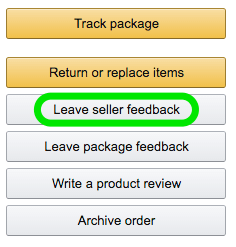
In this post we will be focusing on Seller Feedback as this is the most popular type of feedback especially since many shoppers leave a product review as a Seller Feedback (more on this later on). Seller Feedback is meant to evaluate a sellers performance in three main categories:
- How accurately the product was described in the item listing
- Evaluate the merchant’s packaging and delivery time
- Grade a merchant’s overall customer service and customer experience provided
In order to leave seller feedback a customer needs to click on ‘view previous orders’ and then is presented with a form like this:
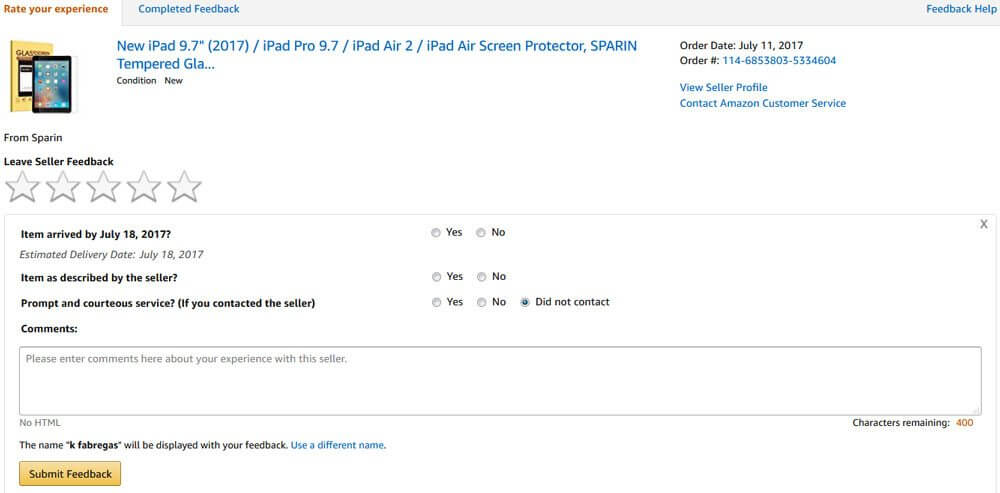
What is considered a good seller rating on Amazon ?
Amazon actually uses these Seller Feedback ‘questionnaires’ and translates them into a more tangible rating. Your standing is measured based on what is called your ‘Negative Feedback Rate’. The absolutely best sellers on Amazon have a 0% Negative Feedback Rate but generally speaking any rate which remains below 5% is considered good.
You can view your Seller Rating by going to your Seller Central dashboard and clicking:
- Performance
- Customer Satisfaction
- Customer Feedback Tab
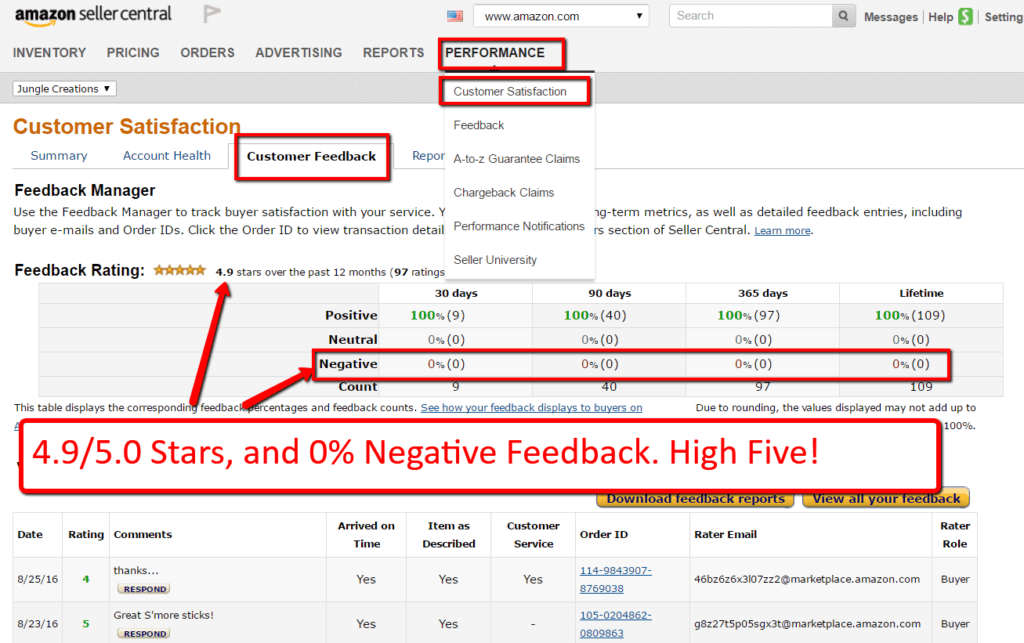
Pro tip: Shoppers have 90 days to leave a review and 60 days are provided to allow for the removal of a review. In both cases, act swiftly, ask for positive reviews and try to immediately resolve issues that arise from negative reviews. The quicker you address the issue, the higher the likelihood of getting a negative review removed is.
Two important Seller Feedback Facts
I would like to mention two important Seller Feedback distinctions/facts you should be aware of:
- Seller Feedback Vs. Reviews –
Though often confused, these are two distinct categories. Despite the fact that both of these use a star-based system and allow open-ended comments the difference is that:- Seller Feedback – Pertains to a customer rating a merchant
- Seller Reviews – Pertains to a customer rating a product
Do note that a seller can be rated multiple times by a customer if he or she makes multiple purchases from the said merchant but products can only be rated once by a customer unless their previous review has been deleted
- Feedback is local –
Amazon has 13 global marketplace, servicing 180+ countries and many people believe if they have great Seller Feedback and reviews in the US it will carry over to other marketplaces. This is a widespread misconception. In this respect, every Amazon marketplace is independent and Seller Feedback and reviews must be built from the ground up in each individual market. This makes a lot of sense as different people from different countries have unique expectations of products and merchants alike so what American customers love, French customers may hate. That said, it may require significant resources to branch out overseas so keep that in mind when weighing this as a possibility.
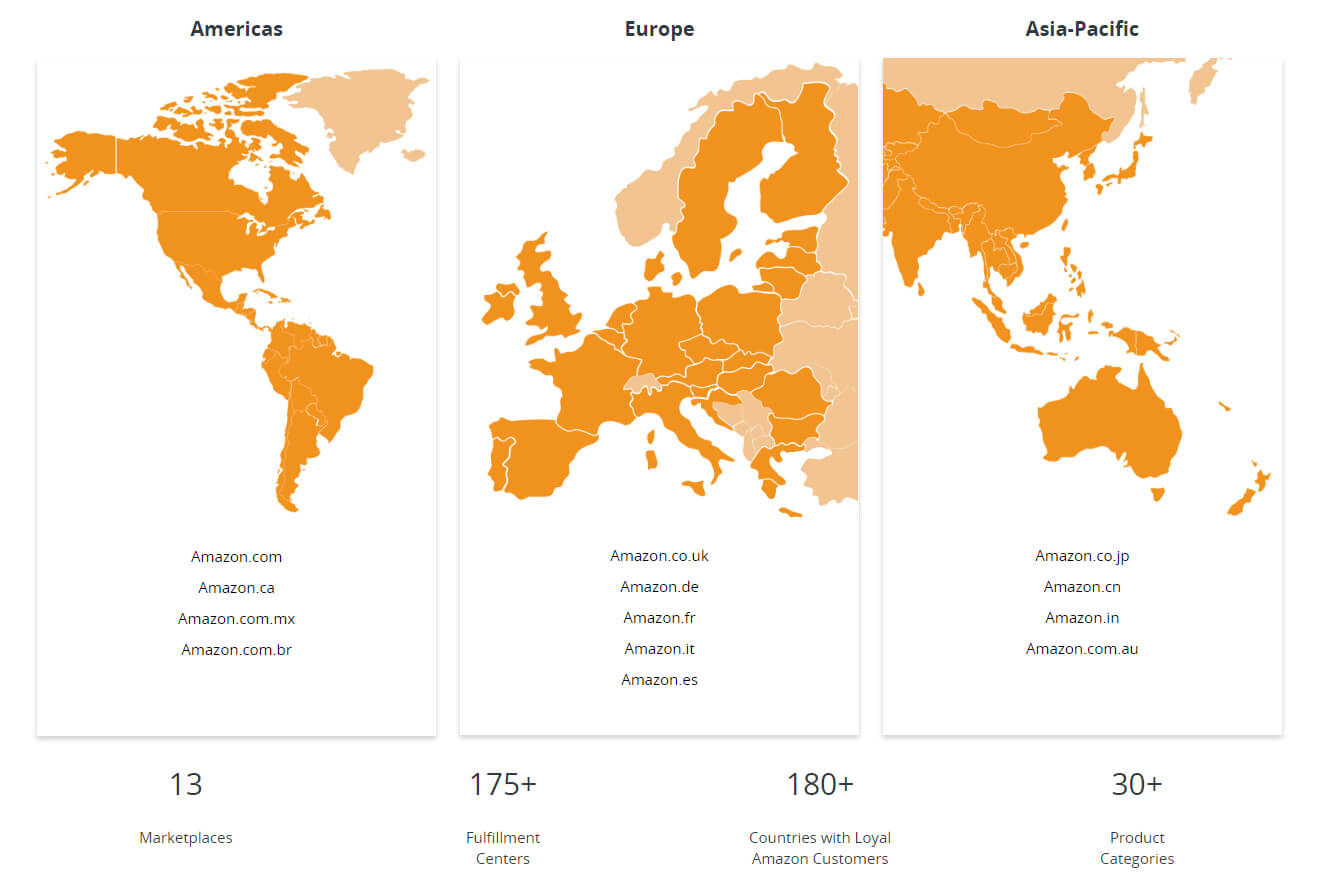
But why is Amazon Seller Feedback so important ?
Before delving into this I would like you to consider the following three statistics:
- 91% of people regularly read reviews
- 84% treat online reviews as if they would a personal recommendation from a friend
- 68% of shoppers form a positive or negative buying decision after reading 1-6 reviews
(Source: Local Consumer Review Survey, 2017)
Now that you fully grasp the importance of reviews let’s look at the two main reasons why Seller Feedback on Amazon is so important:
- Generating future sales – The first and most obvious reason (especially after glancing at the numbers above) is peer-driven shopping. This means that many people today are driven to make a positive buying decision (or negative for that matter) based on a fellow shopper’s review. Reviews are the single best way to attract or repel new business and should be taken extremely seriously by sellers on Amazon!
- The Buy Box – The buy box is a much-desired spot on Amazon as it accounts for an average of 82% of sales on Amazon – merchants get chosen by Amazon’s A9 algorithm based on who will give the customer the best customer experience possible ( which is based, among other things on your Seller Feedback)
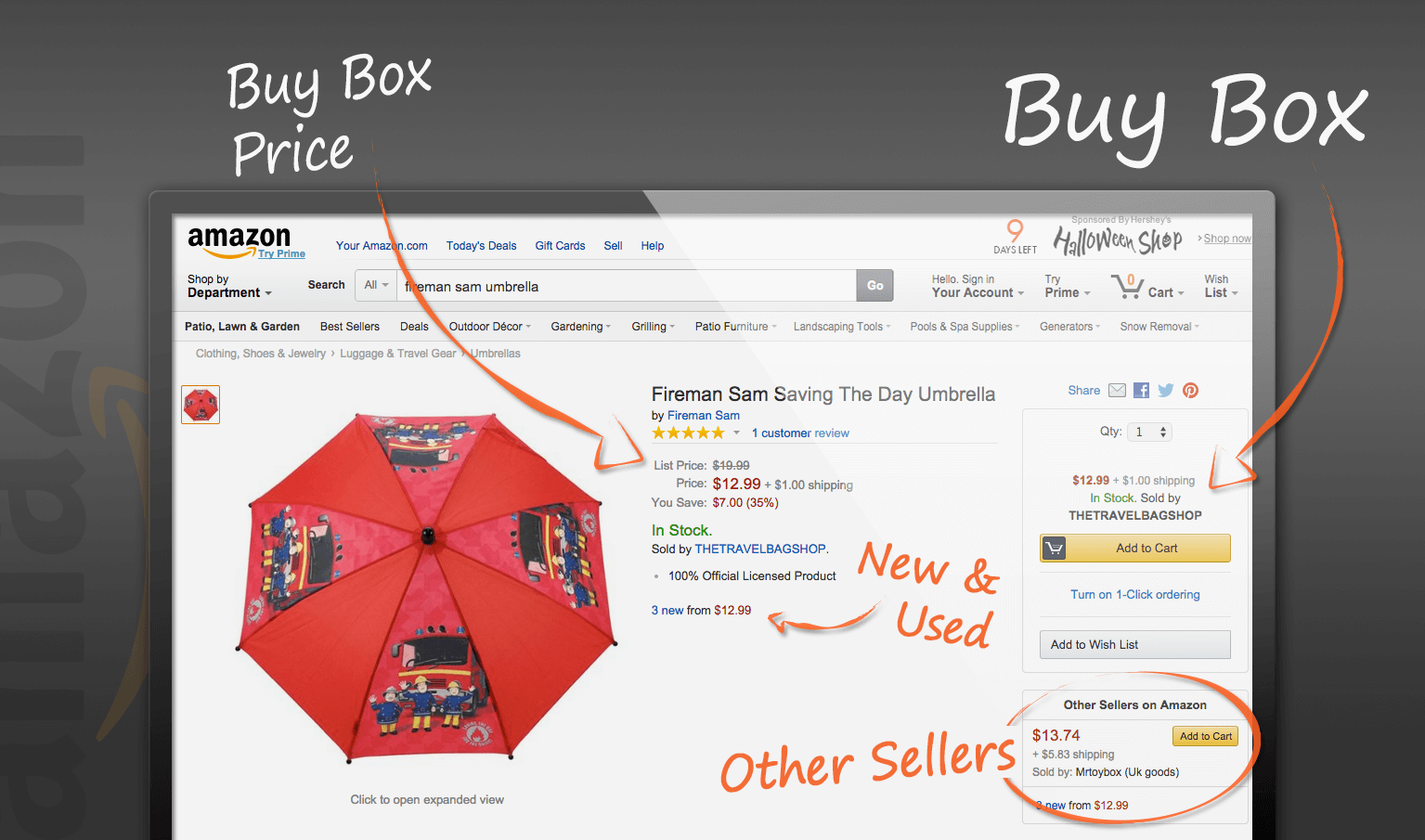
Do keep in mind that it is important to maintain a 97% or higher feedback score when competing for the Buy Box!
How to encourage shoppers to leave you more Seller Feedback ?
To say the least, it is much less common for buyers on Amazon to leave feedback. Consider the following statistic:
Less than 5% of shoppers leave Seller Feedback after making a purchase on Amazon! (Source: Amazon Seller Central Forum)
After digesting this mind-blowing number for a second, especially considering the fact that on eBay, by comparison, the number is around 40%, I would like to tell you that the main reason that a customer does not bother to leave feedback on products has nothing to do with the quality of service or product they received, rather customers simply do not feel strong enough about your items in order to drive them to action.
This statement comes following a recent study was done by the Harvard Business Review which looked into the importance of establishing an emotional connection with consumers:
- Emotionally engaged customers spend 200 % more than your average customer!
- Millennial shoppers are emotionally driven by ‘community’ and ‘self-discovery’
- Shoppers who feel an emotional connection are valued at 52% more than customers who define themselves as ‘highly satisfied’
(Source: Harvard Business Review)
Here are three simple ideas on how to foster an emotional connection with customers and motivate them to leave you Seller Feedback:
- Package to excite –
Imagine you order a new item on Amazon and you have been waiting for it to arrive for a few days and are so excited and when it finally does, you are really disappointed. Not because the product isn’t great – it definitely is! You are disappointed because the box it came in was clearly second hand and the item was carelessly thrown in.
Now imagine the polar opposite scenario, you finally get your item and it is beautifully wrapped, not only that but there is a unique experience when ‘unboxing it’. Maybe part of the packaging becomes a functional component of the product as in this brilliant packaging idea:

Or maybe, you keep it simple but use nice packaging materials and meticulously package the item so as to give your shopper a sense of exclusivity like in this example:

It does not need to necessarily cost a fortune but attention to detail and creating a unique and exhilarating user experience may very well set you apart from your competition and send shoppers running to leave you positive Seller Feedback. One distinct feature that you can focus on for example is the color of your box, by using a unique color such as bright pink, you can enhance the way your customer perceives your brand.
Additionally, ‘unboxing’ has become really popular and many vloggers (ie video bloggers) have posted videos on YouTube which have gone viral which needless to say, if this happens to one of your items, it is great for business.

2. Create engagement –
Creating engagement can also be a great way increase brand awareness but more importantly have shoppers feeling happy, emotionally connected to your brand and ultimately more than willing to leave positive Seller Feedback. Shopper engagement can include a variety of actions:
- Including an unexpected freebie with their current or next purchase
- Offering a discount on your customer’s next purchase
- Opening a pop-up store or promotion booth in a place where you have a lot of customers or in a place where you have no customers but want to raise awareness. For example, imagine you sell swimwear on Amazon and have tons of clients in Miami Beach and for one month open a pop-up booth and advertise this to your customers. This has the potential to create lots of buzz and may have a lasting effect on customer loyalty and Seller Feedback

- Connecting your products to charities where either you can offer to donate a percentage of your revenues to a predetermined charity or a charity of your customer’s choice
3. Ask politely –
Believe it or not, many shoppers are actually unaware of how important their Seller Feedback is and that is why you should always ask your customer to kindly rate you on Amazon. You can do this by:
- Handwriting a note in the package you send over
- Sending a follow-up email
- Offering a discount or promotion to shoppers who leave you feedback
Or you can combine all three. Whatever method you choose, do not feel uncomfortable as Amazon actually encourages merchants to solicit feedback.

How to get negative Seller Feedback removed ?
You did everything right and you have plenty of positive Seller Feedback but just like anything else in life, you cannot please everyone and for whatever reason, you got negative Seller Feedback from someone. Remember that there are two other parties involved here ie Amazon and the customer – I recommend you contact both of them depending on the situation in order to try and resolve the situation and hopefully get said feedback removed:
- Be in touch with Amazon:
It is easier to approach Amazon and request that they remove Seller Feedback than it is to request that they remove a Product Review. The reason is because there is a larger range of possibilities on which to base your request:
- The issue was outside the jurisdiction of the seller for example FedEx lost the package
- The product was delivered to the customer through FBA or Fulfillment By Amazon and the product did not arrive on time or ended up being the wrong item. It is important to mention that once an item is being fulfilled by Amazon, the merchant cannot receive negative feedback
- The review is in fact a Product Review and not Seller Feedback
This last one is pretty clever and allows sellers to use a fantastic loophole which not many people know about in Amazon’s feedback department. This actually allows you to pick and choose which feedback to leave and which to get rid of if the scenario is right. For example, if a customer left a negative Product Review instead of a Seller Feedback, you can open a ticket with Amazon and ask to have it removed. If on the other hand, a customer leaves you a fantastic Product Review where they should have left Seller Feedback, you can choose to do nothing and maintain those positive reviews. Like I said – this is a sweet loophole!
2. Be in touch with the customer:
In order to do this, take a look at your Feedback Manager dashboard – there you can see a variety of information:
- Your rating
- Customer comments
- Arrival time feedback
- Item arrived as described feedback
- Customer service feedback
- And most importantly: Your customer contact information
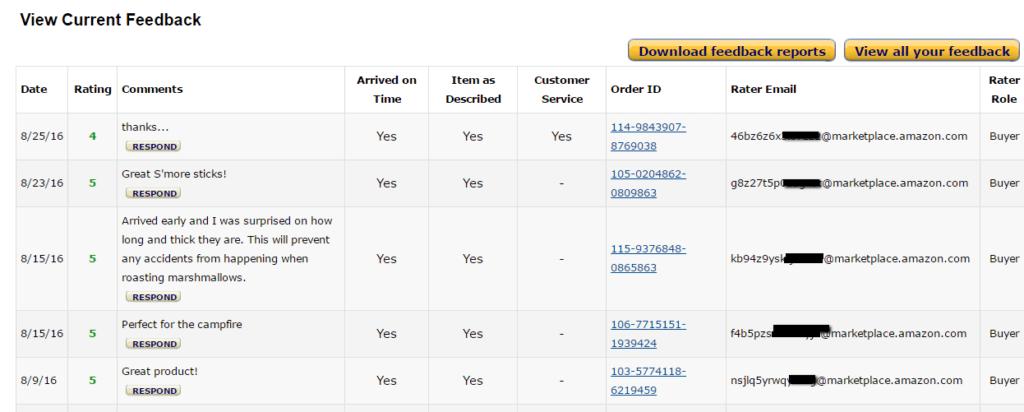
First of all, read the customer’s review and when writing to them make sure to address the concerns they raised in their review. For example, if a customer complained that the item was not as described then maybe offer them a refund or offer to replace the item with a new one. Whatever the concern is, let your customer know that you care and are doing your utmost to remedy the situation. At the end of your correspondence, politely ask that they remove their negative review. Do not use language which can be interpreted as forceful or bullying! This is strictly against Amazon’s policies and may very well get you suspended from Amazon.
How to increase your seller rating percentage ?
First of all, it is important to clear up the difference between your Seller Rating and Seller Feedback:
- Seller Feedback – is the review consumers leave you for the level of service you provide as I described in detail above
- Seller Rating – reflects your success and value as a seller
For every order you (or Amazon for that matter) fulfill, you are graded on a scale from 0 (the worst possible rating) to 100 (the best possible rating) based on a number of categories:
- Shipping speed – Your rating will take a hit if you list that shipping will take a certain amount of time let’s say 2 days but in actuality, it takes you longer, say 4 days
- Cancellations – Your rating will also be affected if a customer places an order and then cancels it
- Credit card cancellations – If a shopper calls in a fraudulent charge on their credit card and that leads back to you that looks bad for you
- Inquiry response time – The more you wait to respond to an inquiry the more this will affect your rating. It is highly recommended that you reply within 24 hours of receiving an inquiry
- Seller Feedback – Negative Seller Feedback translates into lower Seller Ratings
- A-Z claims – This means you did not provide a customer with good enough service so they feel compelled to ask Amazon to step in and sort things out. This too hurts your ratings
Amazon does have a measure of fairness when calculating your ratings though and so they tally up your ratings over the course of the last 365 days and divide that by the number of orders you sent out in order to rate you on average and not only on a case-by-case basis so that if you are generally good but had one or two incidents it won’t harm you as much.
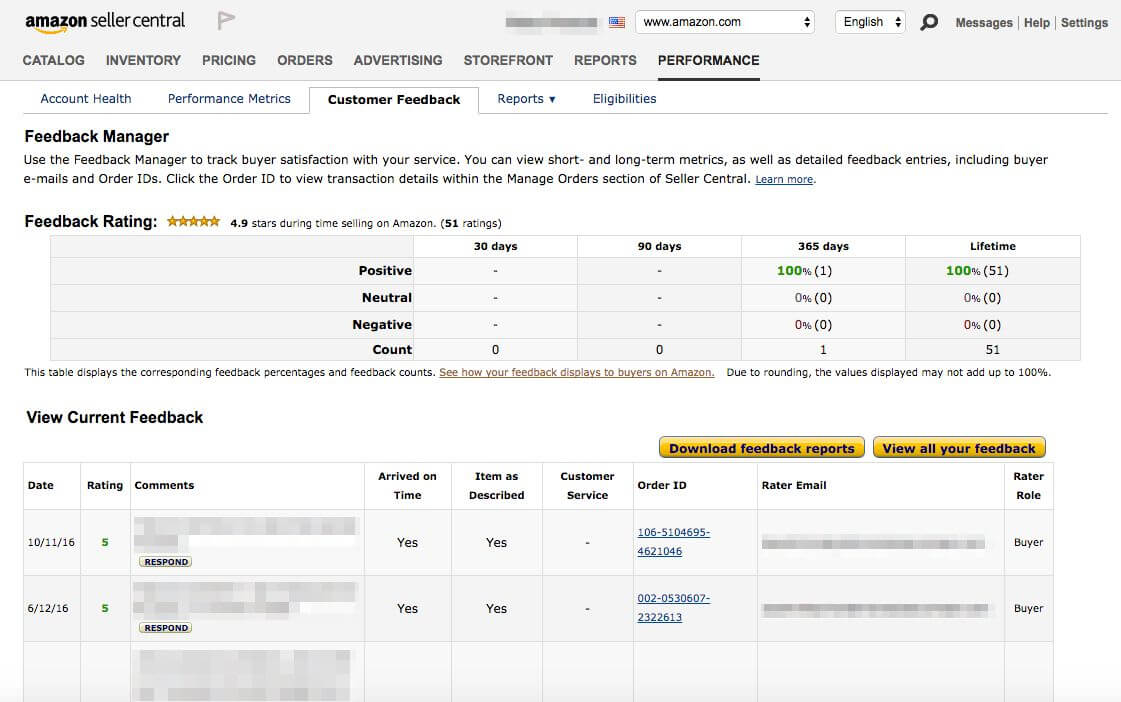
Do keep in mind that some categories carry more weight than other as far as Amazon is concerned. For example an A-Z claim is given more weight by Amazon than a late shipment claim. Also Note, that Amazon does not only penalize sellers but allows you to earn up to 10 extra points per order if deemed that you provided outstanding service. There is no recipe for this and is entirely up to Amazon but many times you will get these bonus points if you get a fantastic Seller Feedback for example.
Summing it up
The bottom line is that nobody ever wants to get negative feedback but sometimes it happens and you just have to know how to approach the situation in the best and quickest way. You should not shy away from asking for feedback from buyers from fear of receiving negative feedback. Reviews are part and parcel of the cloth from which eCommerce is cut. You should however aim to give the best service and encourage positive reviews. Choose whichever tactics work for you but being passive on this issue is not an option! Consider this an opportunity to build up your brand identity as well as a loyal customer base – always aim to turn a negative into a positive and you cannot go wrong.
Please share your Seller Rating and Seller Feedback experiences below – we would love to learn and grow as a community from the knowledge that you share.



